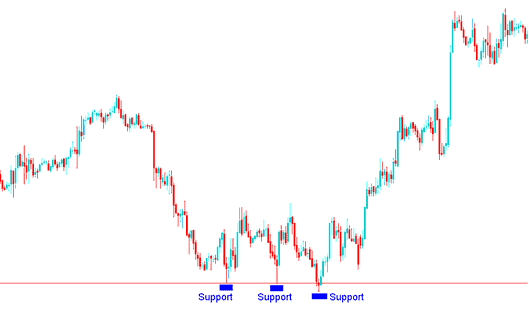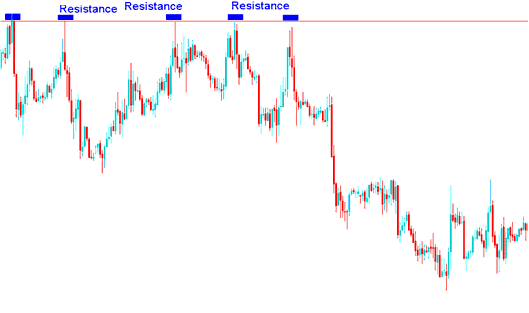Support and Resistance Areas
This is one of the most widely used concepts in cfds trading and it refers to levels on a chart that tend to act as barriers that prevent the price of an asset from getting pushed beyond a certain point in a particular direction.
Support
This level prevents the price of an asset from getting pushed downwards and therefore it is regarded as the floor because it prevents the market from moving downwards past a certain point.
Example:
On the example shown below you can see that cfds price moved down until it hit a support
Once price hit this level it slightly bounced back up, then resumed going down until it hit support again.
This process of hitting a level & bouncing back is called testing the support.
The more times a support is tested and the market bounces up the stronger it is - the example shown below this level was tested three times without breaking. Finally the market trend reversed and started moving in the opposite direction.
Once this level has been determined traders use it to place their orders to buy the cfds at the same time putting a stop loss a few pips below it.

In the example above the market did not move below this area. It is an area where price cannot break lower.
These regions form good points where price trend in a downward trend is likely to reverse and get support and start moving upwards.
The demand to buy the cfds at this point will be greater and therefore providing a good point to begin a buy trade, while placing stops some pips just below.
This support is also use by short cfd sellers as a target where to set their take profit for their short sell trades.
This is another reason why the trend is likely to reverse or consolidate at this level because once the sellers close their sell cfds trades then momentum of the downward trend reduces and a consolidation will happen after which the direction is likely to reverse.
Resistance
This level prevents the price of an asset from getting pushed upwards these levels are therefore regarded as the ceiling because these levels prevent the market from moving upwards
Example:
On the example shown below you can see that cfds price moved up until it hit a resistance.
Once price hit this level it retraced slightly the resumed going up until it hit the resistance again.
The resistance holds & is tested five times without breaking.
More times a resistance level is tested the stronger the it is.
Once this level has been determined traders put their orders to sell at this level & at the same time putting a stop loss a few pips above it.

In the example above the market did not move above this area. This region shows an area where price cannot break above.
These levels form good points where a price in an up-ward trend is likely to reverse after some resistance and start moving downwards in the opposite direction.
This displays that the demand to sell the cfds at this region will be greater & therefore providing a good point to start a sell trade, while placing stops some pips just above this level.
This resistance level is also used by buyers as a target where to set their take profit orders for their bullish trades. T
His is another reason why the trend is likely to reverse or consolidate at this level because once the buyers close their sell cfds trades then momentum of the upward trend reduces and a consolidation will happen after which the direction is likely to reverse and start moving down.


